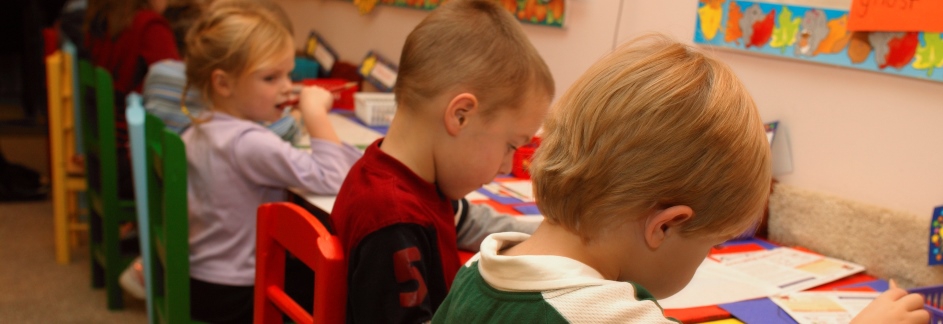The views expressed in our content reflect individual perspectives and do not represent the authoritative views of the Baha'i Faith.
PART I. LIVING INTO A LEGACY
Children spend their first year of life trying to distinguish between “Mama’s needs” and “my needs.” They spend their next three years defining the social boundaries, relationships, actions and expectations established by their family and culture. Some learn to separate, to covet, to snatch, to hit. Others learn to give, to layer knowledge, to collaborate, and to bond through meeting joint challenges. These are the lucky ones.
What could be more productive, over time, than infusing all these formative young minds with the concept of deep connection to the human family as an axis point for their basic learning activities? This question comes to mind especially now, as predictions about the antidotes to extreme gun violence flood the lips of every news anchor and politician in the aftermath of the Newtown, Connecticut shooting. The conversations have focused on finite solutions: policy change and implementation of current policy; mental health procedures and detection of violent tendencies in order to prevent gun ownership among likely shooters; and ultimately, pension fund boycotts of heavy weapons manufacturers.
As a follow-up to these relevant and appropriate conversations, we cannot overlook a discussion of early childhood education, delivered by well-trained educators, for its long-range potential to prevent gun violence from dominating our conversations in another 25 years. When President Obama signaled the need for quality preschool initiatives in his 2013 State of the Union address, an opportunity for long-term prevention gained national attention and a well-deserved jump on the priority list.
 Studies assert that children who did not attend a quality preschool were five times more likely to become chronic lawbreakers by adulthood than were their counterparts. (1) Admittedly, violence through massacre falls into a category all by itself. When amoral drivers precede a violent act because the perpetrator’s neurological or psychiatric functioning nullifies the normal level of shame associated with taking human life, truly, preschool might not have helped. However, these exceptions to the rule should not dissuade us from discussing the nurturing of the general population of children toward a culture that associates innate capacities with community building. Their own early education may better equip the majority of children to come up with improved policies, up-to-date research and empathic solutions for managing mental health challenges in the future. In any case, their innate positive qualities, relationships and lessons learned must ultimately gear their legacy as architects of a more transcendent and cohesive society.
Studies assert that children who did not attend a quality preschool were five times more likely to become chronic lawbreakers by adulthood than were their counterparts. (1) Admittedly, violence through massacre falls into a category all by itself. When amoral drivers precede a violent act because the perpetrator’s neurological or psychiatric functioning nullifies the normal level of shame associated with taking human life, truly, preschool might not have helped. However, these exceptions to the rule should not dissuade us from discussing the nurturing of the general population of children toward a culture that associates innate capacities with community building. Their own early education may better equip the majority of children to come up with improved policies, up-to-date research and empathic solutions for managing mental health challenges in the future. In any case, their innate positive qualities, relationships and lessons learned must ultimately gear their legacy as architects of a more transcendent and cohesive society.
Like every generation, today’s children will eventually face the call to make moral choices about immoral acts. Collecting an arsenal of weaponry rather than arming each new class with heightened pro-social skills takes us farther from the natural trends of the times; for, when measured over centuries instead of decades, we live in the age of literacy, as members of a species leaning away from barbarism as a means of creating law and order. More than at any time in history, we possess the tools and technologies to help almost everyone on the planet hone higher order thinking skills and spiritual capacities in search of a more peaceful coexistence. Technological advances expand exponentially over time, and so must our responsibility to use them wisely, whether the matter relates to conceiving weapons or spyware or cures for disease or inspired approaches to universal education — and then funding the most constructive goals.
These emerging advances and conjoined responsibilities fulfill the Baha’i predictions that over this thousand year epoch, we will inch our way toward a time when
“…through the zeal and ardour of the pure of heart, the darkness of hatred and difference will be entirely abolished, and the light of love and unity shall shine…”(2)
The reference allows a thousand years for this progress toward peaceful cohabitation, and we are only a century and a half into the challenge of the age, so we stumble plenty.
As adolescents of our era, we are not mature yet. Still, seen through the dramatic cinema-scope of time, even without an emphasis on “the light of unity,” the relationship between improved literacy, an increased standard of living and decreasing violence has borne out over centuries past. A quick look at some of the graphs in Steven Pinker’s 2011 tome, The Better Angels of Our Nature, (3) shows that between 1200 AD and 2000 AD, homicide rates in five Western European nations plunged from peaks of almost 100 per 100,000 to fewer than one per 100,000 in most countries. Conversely, income levels rose by 600% during this same time period. Within the middle years alone, book production in the world’s publishing center, England, increased by 700%. These charts suggest a pattern that links informed thinking and reasoning, independent search for truth, and healthy economies with a worldwide reduction in the use of violence as a fallback position for problem solving.
With our widespread exposure to tragedy through constant media exposure, we may not feel the impact of this centuries-long reduction in violence. Nevertheless, it exists, even if the perceived pandemic of bloodshed creates not only a sense of physical assault but an assault on our sense of safely, ironically fomenting fear in the communities with the highest levels of literacy and technology.
In the case of weapons misuse in the United States, a country does not talk itself into violence as an acceptable subculture in a day, nor does it dismantle fear-based thinking in a day. It may take generations to inculcate a sense of universal connection so strong as to replace the fear that impels neighbors to arm themselves against their own society. Assuaging this fear begins with the process of shaping pro-social identities, purposes and relationships at the same formative age at which we teach prereading, math reasoning and play skills. It is perhaps no coincidence, then, that President Obama called for stronger gun control policies along with universal preschools, in the same speech.
The more literate a society, the greater its options for teaching collaboration, unified problem solving, the sharing of natural resources, and technology use that increasingly benefits humankind. These capacities come most naturally when introduced in early childhood and given opportunities for daily application. A “quality” preschool can provide such experiences—and already does in the most innovative schools. These program planners have identified the finest of human instincts and discovered that when we strengthen them through skills-building activities, we also increase motivation to learn and cognitive performance. We unleash our highest human potentialities, by incubating each child’s potential. (4)
The views expressed here are editorial in nature and not intended to represent an official position statement.
Education as Violence Prevention – Part 2
1. Early Education: Fight crime in California.www.fightcrime.org/state/California/early education. 2013.
2. Abdu’l-Baha, Abdu’l-Baha in London, p. 37.
3. Pinker, S. The Better Angels of Our Nature, Viking, New York, 2011; 171,173.
4. CEP/FCL assessments, Los Angeles, California, 1999 – 2009.
You May Also Like
Comments

















Thanks!